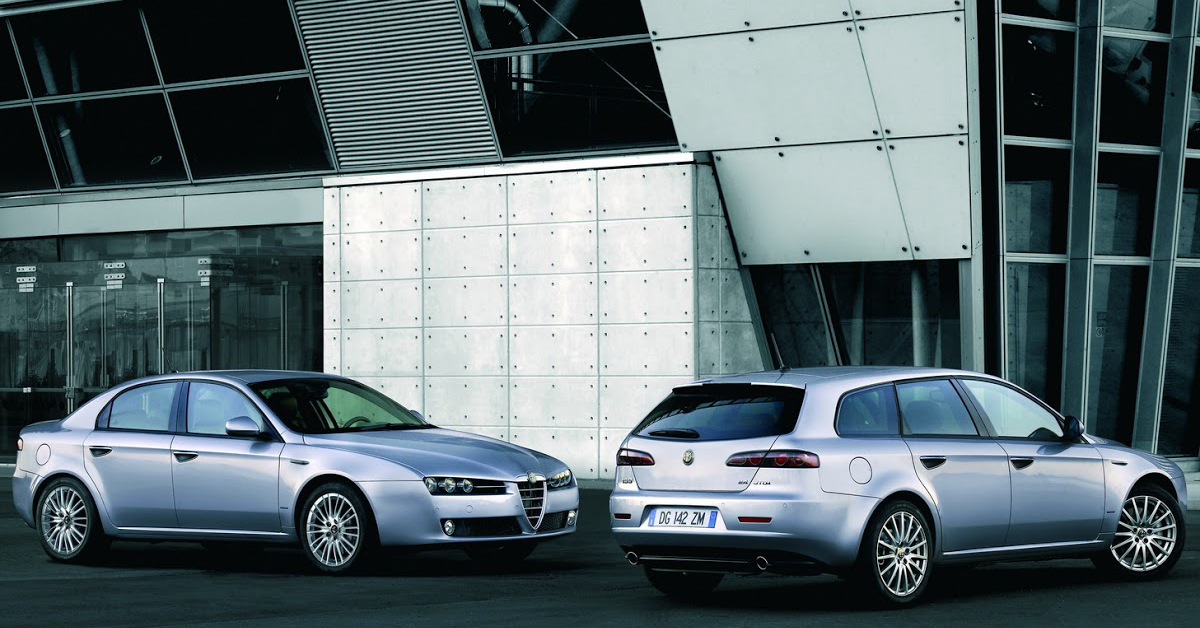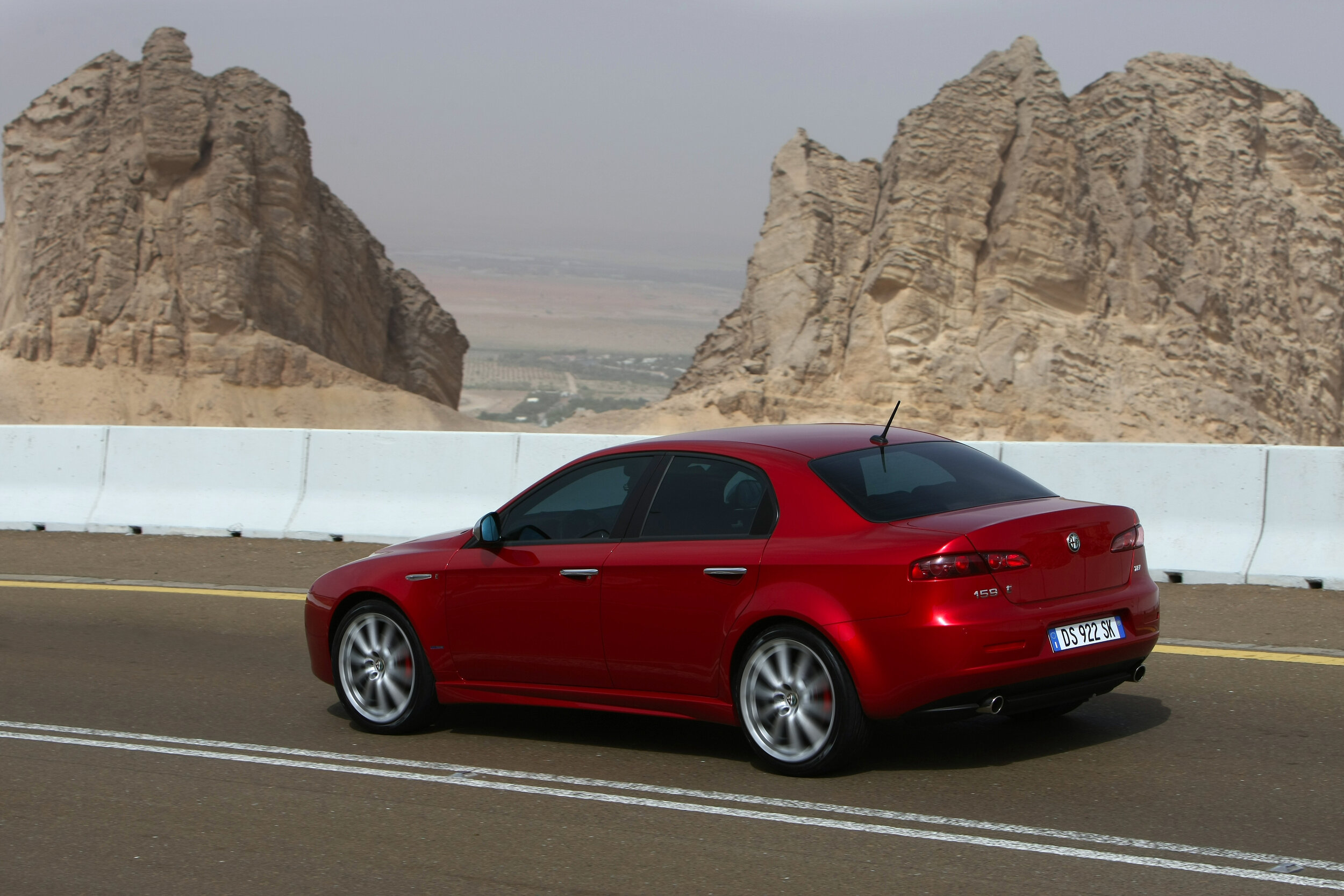The air must have been thick with excitement when the 159 was launched in 2005, appearing as it did at the crest of something of a golden-era for Alfa Romeo. The well-received 147 was still selling well, the timeless 916 GTV and Spider had not yet fizzled out, the supermodel GT had made its stunning entrance, Sr Busso’s masterpiece was still barking loudly and the sublime 156 (the car which had almost single-handedly rebuilt the marque’s standing in the mid-1990s) had gained a new lease of life thanks to its handsome facelift.
Surely the 159 (which was then being touted as the 156’s direct replacement) was going to set the motoring world alight? The first signs were certainly promising; Giugiaro, in collaboration with Alfa’s in house design team, had penned yet another beautiful shape, inspired by his achingly gorgeous Brera concept of 2002. But, behind the scenes, the 159’s birth hadn’t been without trauma.
The 159 as we know it today was actually originally intended to be the replacement for the 166, the 156’s larger, business-suited cousin. Coming out of the ill-fated merger with GM, it was the first car to be built upon the “Premium Platform”. There were big plans for this underpinning, with a whole host of luxury cruisers excitedly announced in the early 2000s. The new Saab 9-5 and 9x, an ambitious new Buick, the Opel Insignia (see picture) and a whole new Alfa range intended to break America were all touted.
The 5.7 V8-powered, 339bhp Insignia concept from 2003
The GM big-wigs, however, deemed the Premium Platform too expensive, abandoning it in the arms of Alfa following their costly divorce from Fiat. In an effort to stop the money haemorrhaging any further, plans were scaled back and the 166’s offspring hastily became the 159 and the great white hope for the brand.
This complicated gestation means the 159 did initially feel a little compromised, its executive pretensions comparing unfavourably to the lithe 156 for many drivers. The clamouring for Atlantic appeal can be felt in almost every inch of the car - nothing is left un-supersized, sitting in the seats is like lounging in an La-Z-Boy and brute force is favoured over Alfa’s usual delicate balance.
However, taken on its own terms, the 159 still has plenty to offer drivers. Huge interior space make them a great choice for families, the increased comfort levels make them ideal motorway-munchers and, of course, their aggressive stance still gives them an incredibly imposing road presence 15-years later. Below we go over some important points to consider when buying a 159.
Cuore Sportivo
When buying any Alfa the first question you’re probably going to answer is “which engine do I want?”. The 159 has no shortage of choice, with nine to consider ranging from frugal oil-burners to turbo-charged, benzina-fuelled thrills.
The Alfa Romeo 3.2 V6 JTS (aka NOT a Busso)
At the entry level of the petrol range is the 1.8MPI. With its 138bhp and 129lb-ft of torque this can feel breathless in the real world. In the mid-range, there are the GM derived 1.9 and 2.2 JTS (Jet Thrust Stoichiometric), delivering 158bhp or 182bhp respectively. Both of these are prone to cam-chain-stretching issues (indicated by blinding warning lights on the dash), which can be rather expensive to rectify. The 3.2 V6 JTS (unfortunately no relation to the much-loved Busso), however, introduces a whole other level of maintenance costs. With its three timing chains just as prone to stretching and numerous variators to replace, this engine simply eats money. While it pulls very well and delivers the best 0-60mph times in the range, to be honest, it doesn’t really warrant the often exorbitant bills.
As you can tell, we’re not exactly enamoured with any of these choices so far. They’re all perfectly functional, but they each lack that distinct Alfa-Romeo essence. The 1750 TBi, however, hits that particular nail squarely on the head. While the 3.2 V6 is, on paper, the faster car, the reduced weight of the 1750 (110kg shaved off over the podgy 3.2 JTS) is telling in the more supple handling. These aren’t the easiest of models to source, and you will pay a premium but, in our opinion, the TBi is the way to experience a 159 if performance is your main criteria.
If more practical and sensible arguments might sway your decision, don’t fall into the trap of disregarding the diesel choices. Ok, like the 1.8MPi, the 1.9 8v is simply underpowered for a vehicle of this size and bulk, but the 1.9 16v, 2.0 and 2.4 variants have plenty to offer beyond healthy MPG readings. We had a 2.4 JTDm Q-Tronic as a daily driver for a while and with its 200bhp mated to a silky-smooth fully automatic transmission, it really highlighted the 159’s autobahn wafting credentials. There are well documented issues on the diesels with swirl-flaps and the like (see Test Drive Checklist below), but taken as a whole they are still no more problematic than most of the petrol lumps.
What’s In A Name?
There are a few different spec’ levels to consider too and, as usual with Alfa, it can be a bit confusing to know what actually differentiates each one. As always, original purchasers could further customise their car individually, so the below info is far from set-in-stone but it’s a rough guide on which features you can expect to find on each model.
Turismo / Turismo Sport
The base level, the Turismo came as standard with a flocked cloth upholstery and 16” alloy wheels. There was also a “Turismo Sport” available, which added sports seats (cloth upholstery again), 17” alloys, the brushed aluminium style interior detailing and a leather steering wheel. The Turismo Sport sold very sparingly, however, and is a very rare find.
Elegante
These can be spotted by their slightly different 17” alloys, stainless steel kick-plates covering the sills inside the doors, the suede-like Alfa Tex upholstery and each one boasts parking sensors and Blue&Me.
Lusso
Probably the most common guise we see 159’s coming to us in. The luxury indicated by the “Lusso” moniker includes leather seats, 17” alloys, auto wipers & lights, parking sensors and the metal style dash trim and matching kick plates.
TI
The Ti moniker (Turismo Internazionale if you want to give it its full name) has been used by Alfa for decades, denoting the most lavishly equipped, most performance focussed models. The 159 Ti exterior was enhanced by red brake calipers seated behind 19” wheels, added sideskirts, satin wing mirror casings, badges on the front wings and the whole thing sits with more a purposeful stance on its lowered suspension. Inside, Ti owners benefit from heated sports seats (these were leather with electric memory functions up until 2010, after which you got half leather / half alcantara), leather steering wheel, red stitched gear knob, black headlining, dark-metal interior trim and Ti badged kick plates, aluminium pedals and gauges.
1750 TBi
As already mentioned above, this is probably our favourite 159 variant here at italicar. Named after the classic 1750, it doesn’t really add unique features but shares its glorious 1.8 Turbo engine with the 4C. We’ll take 197bhp, 236lb-ft, a lightened kerb-weight, sharper steering and handling over some shiny wheels any day of the week!
Limited Edition / James Bond LE
Undoubtedly the rarest of 159 curios, a Limited Edition of just 250 cars were sold to mark the 159’s memorable inclusion in Quantum of Solace. All were finished in black livery and share most of the Ti goodies but missed out on the sideskirts and sports seats.
Test Drive Checklist
As mentioned, each iteration of the JTS (1.9, 2.2 and 3.2 V6) suffer from stretched cam chains. Warning lights will be illuminated when it is severe enough for the timing to have been put out. Check the service history for regular oil changes with the correct, quality lubricants. Scrimping and saving in this area will likely cost the next owner.
The entire 939 generation (159, Brera and Spider) all suffer from badly corroding subframes. This is, again, a very expensive issue to rectify. Check the MoT history for mentions of this and if possible have a look underneath yourself. Does it look like someone’s recently been busy with a brush and some black Hammerite? Prepare for a hefty bill for a new subframe!
Diesel-powered 159’s may suddenly deliver their power above 3000rpm in a noticeable spike. This is indicative of a faulty EGR valve, stuck open and not delivering the boost at the right time. Another regular issue we see is blocked swirl-flaps in the inlet manifold, particularly on the 2.4. This can be severe enough to force the car into “limp-home” mode. The 2.0 JTDm presents much less frequently with these ailments.
Many 159s were fitted with the maligned M32 gearbox (1.9 JTD, 2.2 JTS). These are rather weak and commonly suffer bearing failure. To test for signs of this, listen for a whine in sixth gear. You will notice it coming and going as you press and release the throttle, and there may be a visible “jump” to the gearshift as you release the clutch.
If you’re looking at a 159 Ti, check the rear springs as these are known to fail. Many owners replace the standard components for Eibach Pro springs.
Don’t be surprised if the front tyres are worn - the 159 has an addiction to devouring them! 4 wheel alignments should be considered an essential part of your regular upkeep.
The italicar 159 Sportwagon workhorse
To prove we put our money where our mouth is, we’ve been running a 1.9 JTDm 16v Lusso Sportwagon for a few years now. It may have its share of battle scars now and has thrown up a few issues over this time, but we still love it.
If you have any further questions about sourcing your own 159, or would like our assistance in maintaining one in prime form, please feel free to contact us.













